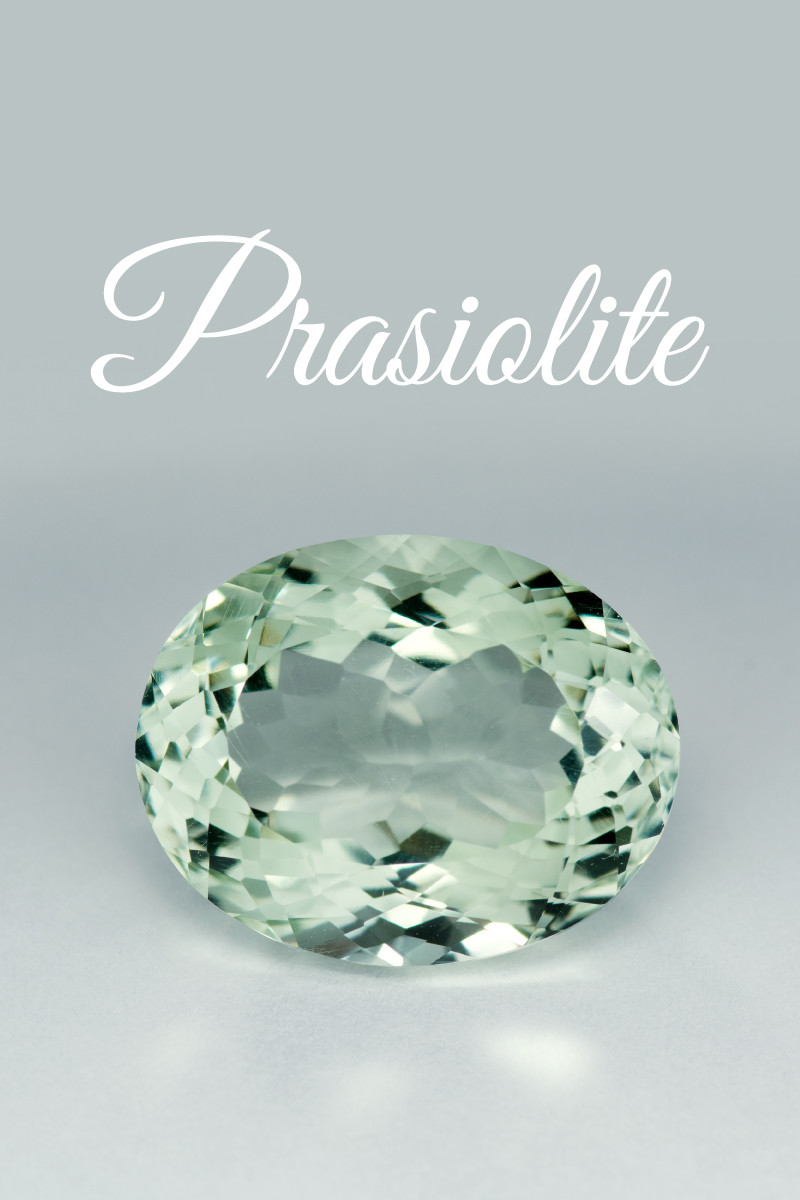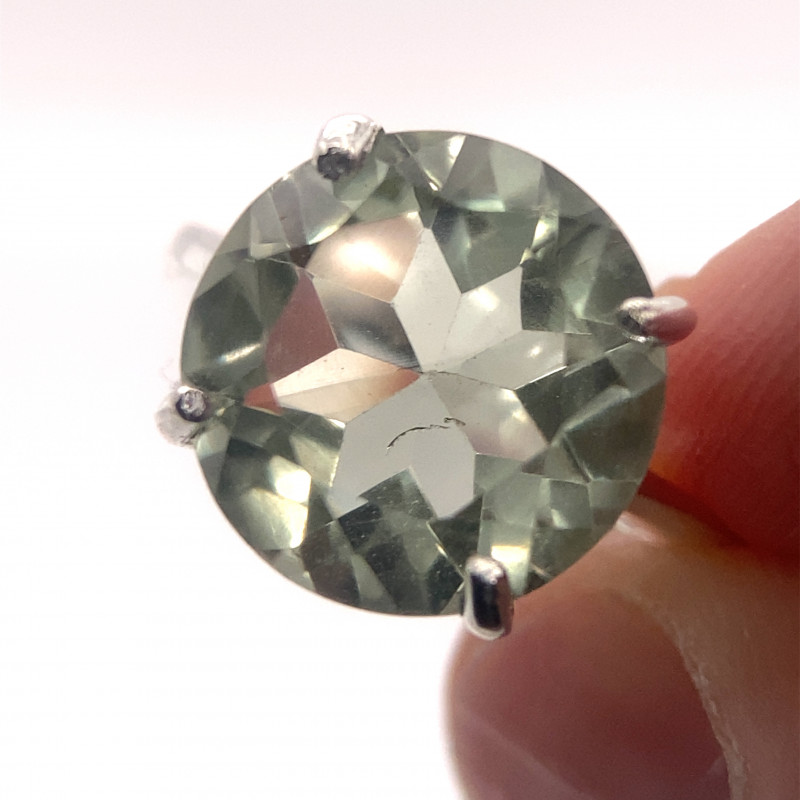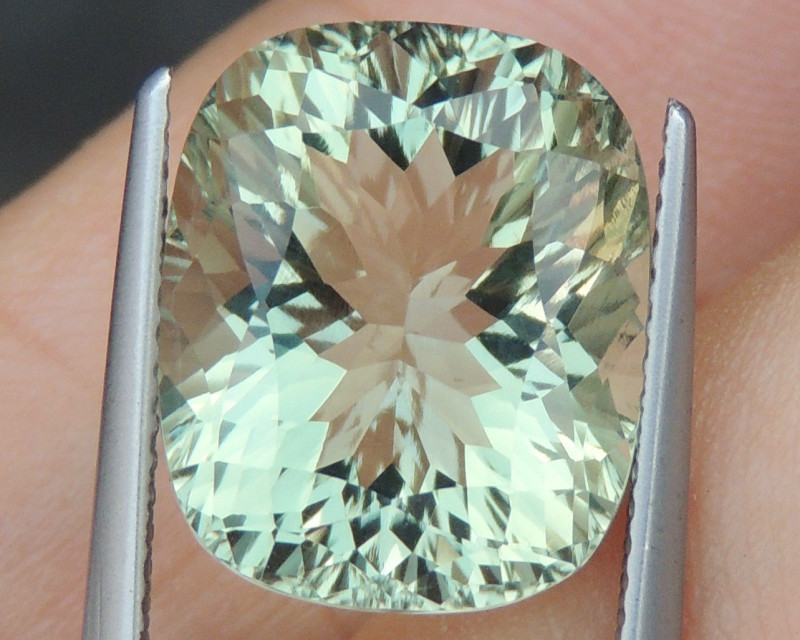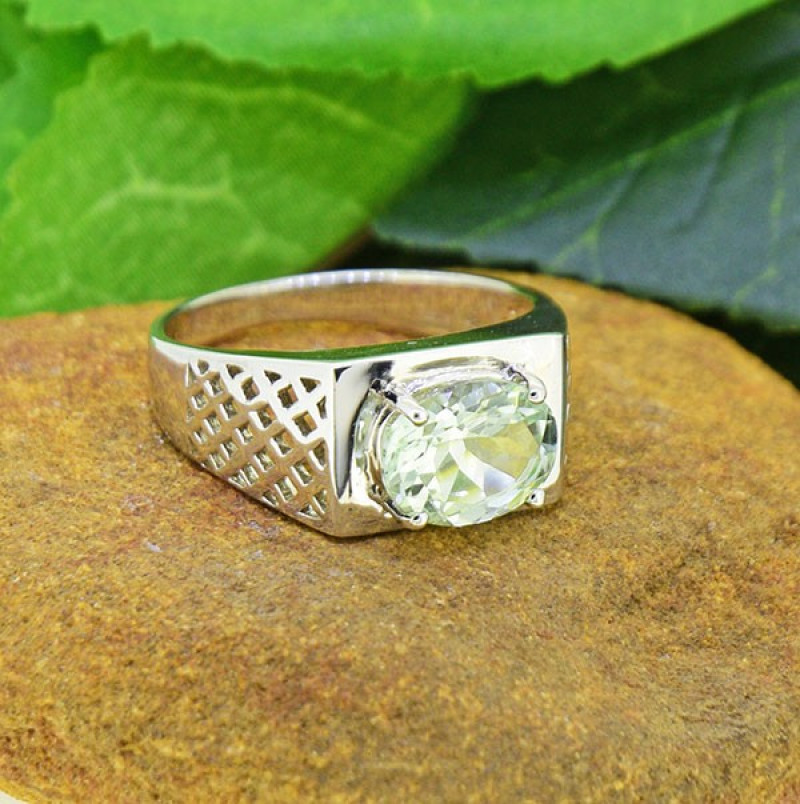
Prasiolite Gemstone: Properties, Meanings, Value & More
 Prasiolite gemstones are translucent, pale green quartz stones created naturally or synthetically by heat-treating amethyst. Is prasiolite green amethyst then? Yes in a sense, but “prasiolite” or “green quartz” are more accurate terms.
Prasiolite gemstones are translucent, pale green quartz stones created naturally or synthetically by heat-treating amethyst. Is prasiolite green amethyst then? Yes in a sense, but “prasiolite” or “green quartz” are more accurate terms.
Prasiolite, amethyst, citrine, and rose quartz are all types of colored quartz stones! Also, the correct prasiolite pronunciation is “PRAYS-ee-oh-light.”
Ready to learn more about this green scientific wonder? Keep reading to learn about prasiolite properties, uses, value, and more!

About Prasiolite Stone
Prasiolite gemstones have soft shades of honeydew-green, though a small amount is darker green.
Is prasiolite a precious stone? No, prasiolite is a semi-precious gemstone. The only precious gemstones are diamond, sapphire, ruby, and emerald.
Speaking of emerald, did you know it’s the traditional gemstone for celebrating the 20th wedding anniversary? Emerald can be expensive, though, so prasiolite is a more budget-friendly option!
Similarly, if you don’t like the traditional purple February birthstone amethyst, you can opt for the more earthy prasiolite birthstone. Prasiolite also acts as a zodiac stone for earth signs Virgo and Capricorn!
You may see prasiolite with other names like vermarine, amegreen, green quartz, or green amethyst. However, the Federal Trade Commission has stated that labeling prasiolite as a “green amethyst stone,” is misleading.
Mineral Characteristics
Prasiolite is a quartz mineral composed of silica. Quartz stones may be macrocrystalline or microcrystalline, and prasiolite quartz is macrocrystalline.
Most prasiolite is created through heating or irradiating amethyst, either naturally or in a lab. Prasiolite hardness ranks at 7 on the Mohs mineral hardness scale. However, impure prasiolite may rank lower.
Given its similarities to so many gemstones, let’s look at how you can tell prasiolite apart from similar-looking stones.

Prasiolite vs. Similar Gemstones
Even if you’ve never heard of prasiolite, you’re probably familiar with a similar green gem, peridot (or chrysolite). Is prasiolite the same as peridot? No, but for bargain hunters, prasiolite is a more affordable alternative to peridot, as well as for tsavorite or emerald.
The main difference between prasiolite vs. peridot is that peridot is an olivine mineral and prasiolite is a quartz. The easiest way to distinguish them is by crystal symmetry: peridot is orthorhombic while prasiolite is trigonal.
Prasiolite is also spelled “praziolite,” but it isn’t prasolite or praseolite. All three have similar coloring, but prasolite is a softer, opaque chlorite mineral and praseolite is a heat-treated iolite.
Another potential mix-up is the chalcedony mineral chrysoprase. Chrysoprase is only translucent (not transparent) to opaque and has a brighter yellow-green color than prasiolite.
You’ll find all of prasiolite’s mineral properties below!

Prasiolite Specifications & Characteristics
Color: Typically light green or pale yellow-green
Crystal structure: Trigonal
Luster: Vitreous (glass-like)
Transparency: Transparent to translucent, rarely opaque
Refractive index: 1.54-1.55
Density: 2.60-2.69
Cleavage: None
Fracture: Conchoidal
Streak: White
Luminescence: Sometimes fluorescent; Usually inert in SW-UV & LW-UV
Pleochroism: Sometimes dichroic; Very weak; Blue-green and yellowish olive-green
Science? Done! But what is the meaning of prasiolite gemstone spiritually?

Prasiolite Gemstone Meaning
Prasiolite’s name comes from the Greek word prason for “leek.” Leeks are a light green vegetable similar to chives, and prasiolite was named for its similar coloring.
This green gemstone symbolizes compassion, abundance, and self-reliance.
Crystal healers call prasiolite a stone for prosperity, stating its symbolism in abundance and self-reliance help attract the best opportunities for success. The stone is said to give you the self-belief to pursue those paths to success with insurmountable willpower.
With the metaphysical meaning covered, what are the metaphysical properties of prasiolite?

Prasiolite Healing Properties
The color and energies inside gemstones can make them powerful healing stones, prasiolite included!
As a green gemstone, prasiolite can offer feelings of purpose, peace, and positivity. Since it started as amethyst, prasiolite also carries some of the healing properties of purple gemstones, like enhancing passion and spiritual awareness.
What is prasiolite good for in terms of physical, emotional, and chakra healing?
Physical Healing
The physical healing properties of prasiolite may include clearing toxins from the body. It’s said to neutralize acids in the stomach, helping absorb more nutrients and prevent acid reflux. Other purported benefits include easing ulcer pain and treating tumors.
Emotional Healing
Emotionally, prasiolite may increase compassion, both inward and outward. The crystal is said to be very nurturing, encouraging self-acceptance and healing emotional scars.
If you feel controlled by fear, prasiolite can give you the strength to combat anxious thoughts and overwhelming emotions. Prasiolite is also said to help you be mindful and present in the moment.
Chakra Healing
Chakra healing involves balancing your seven chakras, energy centers that connect to stages of wellness and development. One common method is by using chakra stones!
Prasiolite opens the heart chakra, where we learn how to love. If the heart is blocked, you may feel undeserving of love and isolate yourself from others emotionally.
Balancing the heart chakra with prasiolite invites feelings of empathy, self-love, and vulnerability.
Before you run out to buy some prasiolite, make sure you know its gemstone properties to get the best deal.

Prasiolite Gemstone Properties
When determining the objective value of a gemstone, experts look at the stone’s value factors (gemstone properties). Prasiolite value factors include color, cut, clarity, and treatments.
Color
Most prasiolite on the market has pale green or yellow-green coloring, but some treatments make it darker green. Prasiolite may also have purple color zones from the remaining amethyst.
The cause of prasiolite’s color can vary between natural irradiation or heat, artificial treatments, or iron ions in quartz’s crystal structure.
Some prasiolite crystals show dichroism, meaning you’ll see two different colors from different angles, in turquoise and pale olive green.
Cut
Gem cutters often shape prasiolite into standard or fancy faceted cuts. Cutters may also opt for non-faceted cuts, like cabochons, beads, or carvings. Generally, faceted cuts have higher value, though the intricacy and craftsmanship of a carving may command high prices.
Clarity
Clarity describes the amount and visibility of a gemstone’s inclusions. The colored gemstone clarity grade of prasiolite is Type II, meaning it usually has some minor inclusions that may be visible.
Inclusions in prasiolite may be partly healed fractures, negative crystals, liquid, or two-phase inclusions (cavities filled with liquid and containing gas bubbles). Visible inclusions can lower prasiolite’s value.
Treatments & Synthetics
By now, you know treatments are commonplace (if not essential) for most prasiolite gems. Today, nearly all prasiolite on the market has been heat-treated and irradiated.
Heat treatments can change an amethyst’s color from purple to yellow or orange (at around 350°C) to create citrine or green (at around 500°C) to create prasiolite. Heat causes amethyst’s iron content to transform, altering the color.
Jewelers may use irradiation on its own or in addition to heating. The process involves changing the atom’s structure in the crystal lattice through a cobalt-60 irradiator or bombarding its neutrons or electrons.
The result is a different colored stone with less visible inclusions. However, heating the irradiated stone to 500°C can erase its green color. Plus, irradiating the stone without keeping it at a constant 150°C can make the color fade.
Prasiolite may also be synthetic quartz, grown in labs through a hydrothermal method. This method involves imitating the natural conditions for crystal growth by dissolving nutrients in an iron-salt water solution and allowing crystals to grow as the solution gradually cools.

Prasiolite History
The first discovery of natural prasiolite was during the early 1800s in Silesia, Poland. The Polish prasiolite specimens were olive-green and sometimes formed the outer layer of geodes while agate formed the inner layer.
However, these Silesian prasiolites weren’t officially described until 1990, when a group of Ukrainian and Polish scientists published a scientific analysis. The analysis later helped prove that prasiolite could form naturally.
Before the 1990 analysis, prasiolite was only considered a heat-treated amethyst. Starting in 1950, American jewelers began selling treated amethyst from Brazil as prasiolite or “green amethyst.”
An important mine in prasiolite’s history is in the Four Peaks area of Arizona, USA. Gemologist John Sinkakas was the first to identify the potential for heat-treating the mine’s amethyst into prasiolite. Later, scientists believed prasiolite formed in Four Peaks naturally.
How do these natural prasiolite stones form?

Prasiolite Origins & Sources
Miners usually uncover prasiolite in igneous, metamorphic, or volcanic rocks beside amethysts.
Scientists theorize Four Peaks prasiolite started as iron-included clear quartz that underwent natural irradiation to create a color center. From there, increasing heat made it change to amethyst, then citrine, then prasiolite.
A California deposit near Susanville has prasiolite alongside amethyst and citrine at the bottom of exposed metavolcanic rocks. Here, prasiolite likely started as amethyst that formed within solidified lava cavities.
The amethyst started as clear quartz with traces of iron that became purple when the lava’s radioactive minerals caused natural irradiation. A more recent (and hotter) lava flow added heat, transforming the amethyst into prasiolite.
After forming, where is green quartz found?
Mining Locations
Currently, the most abundant prasiolite sources are the Montezuma Mine in Brazil and various other Brazilian locales. Prasiolites from both locations are synthetically treated amethyst, but Montezuma amethyst is heated while other Brazilian amethyst is irradiated.
Outside of Brazil, only some places produce amethyst that can become prasiolite:
Bolivia
China
India
Madagascar
Mexico
Mozambique
Poland
Tanzania
Thailand
Uruguay
USA (Arizona, Nevada, New Hampshire)
Zimbabwe
Natural prasiolite has been found in:
Poland
Canada (Thunder Bay)
Tanzania
USA (Arizona, California)
Namibia
Zambia
Location aside, what is prasiolite worth?

Prasiolite Price & Value
Based on its origins, you can see that treated-amethyst prasiolite is more abundant than natural prasiolite. Given the rarity of natural material, how expensive is prasiolite? Faceted prasiolite can range from $5-$50 per carat, but they’re typically $3-$8 per carat.
Natural prasiolite may or may not be more expensive than its treated counterpart, depending on the seller, ranging from $4-$200 per carat in less saturated, faceted gemstones. Interestingly, more saturated natural gemstones are usually $2-$9 per carat at wholesale prices.
The highest-valued prasiolite gems have more saturated coloring and well-proportioned faceted cuts, often called “Excellent” or “Ideal” cuts. These gemstones are typically $7-$9 per carat.
Prasiolite cabochons are around $3-$4 per carat, while beads range from $0.30-$2 per carat. Raw prasiolite is the most affordable, from $0.20-$0.75 per carat.
Lastly, let’s discuss how to make your prasiolite gem last!
Prasiolite Care and Maintenance
With no cleavage and good durability, you can safely wear prasiolite daily, even a prasiolite ring! However, if you’re participating in strenuous activities or hands-on hobbies that could lead to a hard blow to the stone, take off your prasiolite jewelry first.
That being said, can you put prasiolite in water? Yes, prasiolite can go in water, but avoid leaving it in hot water, saltwater, or soaking in any water.
To clean prasiolite, it’s best to use lukewarm water and mild soap, scrubbing away dirt with a soft brush if necessary. After cleaning, dry your prasiolite with a microfiber cloth.
Heated or irradiated prasiolite can lose its color in the sunlight. If you have a prasiolite necklace, keep it under your shirt on sunny days or leave it at home. High heat can cause color fading too, so store prasiolite away from heat sources (radiators, windows, etc.) and don’t leave it in a hot car.
For storage, we recommend keeping prasiolite in a dark container away from other gemstones.
Singing Prasiolite’s Praises!
When it comes to the gentle pastel coloring and myriad of uses for prasiolite, we’ll quote English musician Fatboy Slim to summarize our thoughts: “I have to praise you like I should!”
Prasiolite may be widely known as an affordable alternative to peridot, but it’s also a crystal for empowerment and love. For quartz-loving gem collectors, prasiolite is an essential addition to your collection!
Search the Gemstone Encyclopedia
Related Auctions
Related Articles
Originally the Birthstones or gemstones were associated with a zodiac sign or the month of a individuals birth. Find out what your stone is and view the stones we have for sale
8th Feb 2021
There are dozens of quartz and chalcedony gems with various colors and patterns. Learn all about quartz properties and every type of quartz, from amethyst and agate to plasma and phantom quartz!
15th Oct 2020
Hackmanite is a pink to violet sodalite gem known for its unique color-change and luminescence. Learn why hackmanite is special, from its rare qualities to the types of hackmanite jewelry available.
28th Mar 2018
Latest Articles
Yugawaralite is a rare colorless, white, or pinkish zeolite crystal named for its discovery in Yugawara, Japan. Here we uncover the multifaceted history, properties, prices, and uses of yugawaralite.
24th Mar 2025
Simpsonite is a lesser-known mineral known on the gem market for its durability, yellow-orange color, and rarity. Discover all the properties, uses, prices, and history of simpsonite.
3rd Mar 2025
Kurnakovite is a colorless crystal related to inderite and rarely faceted but known among collectors. Explore the mineral traits, history, prices, and more in this kurnakovite guide.
17th Feb 2025
Article Categories
How To's is where you will find helpful articles from gem Rock Auctions on how to cut gemstones, select gemstones and buy gemstones.
9 Articles





